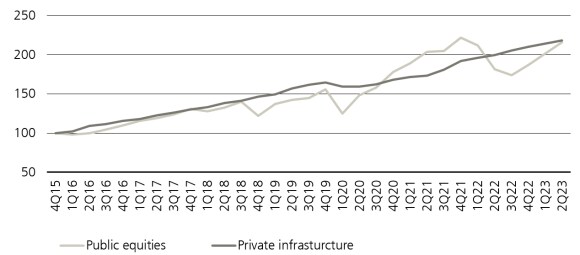Buy the Dip
Should we wait for the infrastructure correction to buy the dip?

We believe that not having to worry about market timing is an underrated feature of private infrastructure – considering market timing is notoriously difficult even in other asset classes.
Alex Leung, Head of Infrastructure Research & Strategy
Recent data shows no drawdowns in private infrastructure
Recent data shows no drawdowns in private infrastructure
Given there is already a lot of skepticism around private infrastructure valuations, as discussed in the previous section, some investors are waiting by the sidelines hoping for a better entry point. They look at the large drawdown and rebound in listed equities in the last two years as an example of how profitable it is to get the timing right.
We have also seen other non-infrastructure strategies pointing to recent drawdowns as unique buying opportunities for their asset classes. As much as there is some marketing appeal in pitching the same story about infrastructure, that is simply not the point of investing in the asset class. One of the main value propositions of private infrastructure is that it has historically displayed low volatility and low correlations compared to other asset classes.
Looking at recent data, we have not seen any major drawdowns in private infrastructure, even though public equities were highly volatile during the same period. This means that compared to public markets, the upside of getting the timing right is limited, while the downside of getting the timing wrong is also muted.
Private infrastructure performance vs. global listed equities (Indexed to 2015)

We believe that not having to worry about market timing is an underrated feature of infrastructure – considering market timing is notoriously difficult even in other asset classes.
- 2024 Infrastructure outlook
- 1. Valuations: is infrastructure’s resilience too good to be true?
- 3. Deglobalization: if this is real, why are trade volumes still rising?
- 4. Digitalization: is AI just another fad for digital infrastructure?
- 5. Decarbonization: are we underestimating the clean energy backlash?

